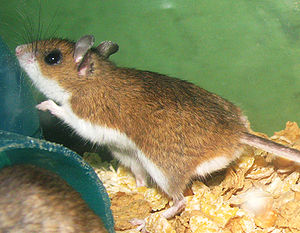Field Guide/Mammals/Deer Mouse
< Field Guide | Mammals
Deer mice not only cause the destruction of current crops, but they may also prevent the regrowth of new plants and crops.[1]
- ↑ a b c d e Bunker, A. (2001), "Peromyscus maniculatus", Animal Diversity Web, retrieved October 8, 2012
- ↑ a b c d e Graham, D. (n.d.), "Deer Mice", Northern State University: Aberdeen, SD., retrieved September 24, 2012
- ↑ a b c d e f g Quinn, N.; Baldwin, R. A.; Timm, R. M. (n.d.), "Deer Mouse Management Guidelines—UC IPM", Home Page – UC Statewide IPM Program, retrieved September 24, 2012
- ↑ a b c d Timm, R.; Howard, W. (n.d.), "White-footed and Deer mouse, Peromyscus maniculatus, control and management", The Handbook: Prevention and Control of Wildlife Damage, no. 1, pp. 1–22, retrieved September 24, 2012
| Peromyscus maniculatus (Deer Mouse) | |
|---|---|
|
Family: Cricetidae
Size: Deer mice range in size from 5 to 8 inches (127 mm to 203.2 mm) long. An average weight for deer mice is only about 0.59 oz to 3.88 oz (15 to 110 grams). Newborn mice only weigh 0.04 oz to 0.07 oz (1 to 2 grams). Depending on the species, the tail may be significantly shorter or longer than their body.[1]
Description: Deer mice acquired their name because of their similar characteristics to deer. For example, they have the same type of fur that is dark on the back and white on the legs and underside with a bicolored tail that is dark on top and light on the bottom. In addition, they are agile and can jump and run similar to deer.[2] Peromyscus maniculatus have rounder bodies with large, black, beady eyes and large ears with little hair.
Similar Species: Because there are seven different types of mice within the species Peromyscus, it is hard to tell the difference between each subspecies.[3] Deer mice are the most common and widespread of the species and can be identified by their larger eyes and ears, overall body size, and bicolored tail. House mice have nearly furless tails with a predominately gray-brown coat.[3] When comparing species, the North American deer mouse has smaller forelimbs than hind limbs.[1]
Range: The deer mouse has one of the most extensive geographic distribution of any North American rodent. They range in areas from Canada to subtropical Mexico.[1]
Habitat: The deer mouse occupies almost every type of habitat within its range such as forests and grasslands.[4] One of the only types of habitats they avoid are wetlands.[2]
Diet: Deer mice feed primarily on seeds but may also consume fruits, invertebrates, fungi, insect larvae, and green vegetables.[3]
Activity: Deer mice are nocturnal and spend the day sleeping in their nests. They build their nests out of stems, twigs, leaves, roots, and other fibrous materials. The inside of their nests may be lined with fur, feathers, or cloth. Often time, nests are found in tree hollows, stumps, roots, and under rocks and logs but are always within the deer mouse’s range of 1/3 to 4 acres.[3][4] Unlike some species, deer mice do no hibernate. Instead, they become torpid during extreme weather but remain with their family in their nest.[3]
Reproduction: Deer mice reproduce depending on the type of climate they live in. In warmer regions deer mice will typically breed year round, typically every three to four weeks, from spring until fall. In cooler regions, deer mice often do not breed during the winter or undergo delayed implantation. The gestation period for females is about three weeks. Females will have about 2 to 4 litters per year with about 1 to 8 young per litter.[4] Upon birth, babies are blind, deaf, and have transparent skin and whiskers.[2] In only one week a baby mouse will have doubled in weight. After about 2 to 3 weeks, females wean their young and they become sexually mature at 7 to 8 weeks. Usually mice born in the spring and summer will breed within the same year.[2] Mates stay together during the breeding season but will take new mates in the spring.[4]
Lifespan: When in captivation, the North American deer mouse can live up to eight years but wild deer mice only live up to a year or less on average.[1]
Notes: Unfortunately, deer mice are the primary carriers of the hantavirus. Hantavirus is a dangerous syndrome affecting many humans throughout the United States. It is a pulmonary virus that affects the lungs of humans. First recognized in 1993, this virus has spread and has affected 131 people in the United States. Of the people affected, half have died.[2] People are suggested not to handle wild mice and to report sightings. If droppings are found, it is advised to use disinfectant solutions, such as Lysol or bleach, for a ten minute duration before removing the droppings from the area.[3] Deer mice can also be harmful to agricultural crops because seeds are their number one food source. Crops that have the ability to be affected are seeds in row crops, melon, alalfa, almonds, avocado, pomegranates, and sugar beets.[3]
|
 |